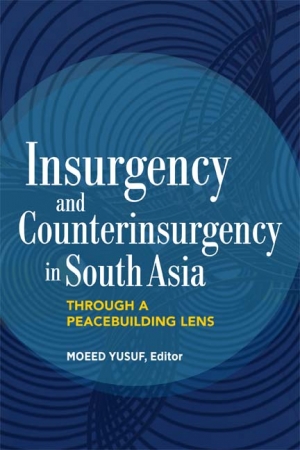In Insurgency and Counterinsurgency in South Asia, ten experts native to South Asia consider the nature of intrastate insurgent movements from a peacebuilding perspective. Case studies on India, Pakistan, Nepal, and Sri Lanka lend new insights into the dynamics of each conflict and how they might be prevented or resolved.

Available May 2014
Questions & answers with Moeed Yusuf http://www.usip.org/questions-and-answers-moeed-yusuf
“These excellent case studies shift the counterinsurgency focus to the origins and gestation of insurgencies and show how they grew into major regional conflicts. With helpful maps and chronologies, data-rich chapters by South Asia specialists reveal how four insurgencies became intractable. Having traced their emergence through the lens of the ‘conflict curve,’ the book’s findings challenge the peacebuilding, development, democracy-building, and human rights communities to concentrate more of their energies on the pre-crisis stage of ‘unstable peace’ in the many existing quasi-democratic weak states, when their tools can be more effective in avoiding the carnage and threats from potential insurgencies.” —Michael S. Lund, senior associate, Management Systems International, Inc. “This timely and accessible volume astutely employs the lens of peacebuilding to analyze the issue of insurgency in South Asia, a phenomenon which has, until now, received proportionately little attention. The contributors provide first-rate analysis and practical conclusions that will be of use to both scholars and policymakers. The case study approach is particularly welcome, as it will benefit both regional specialists, as well as peacebuilders seeking wider lessons about the elements of successful interventions across the conflict cycle.” —Abiodun Williams, president, The Hague Institute for Global Justice Insurgency and Counterinsurgency in South Asia underscores the need for South Asian decision makers and relevant actors around the world to systematically examine the nature of intrastate insurgent movements. Using the “conflict curve” theory of conflict evolution, ten experts native to South Asia consider the trajectories of four of the most salient armed insurgencies in a region that has experienced many such sustained conflicts and the counterinsurgent response to each. Case studies on India, Pakistan, Nepal, and Sri Lanka lend important lessons on the dynamics of each conflict while collectively offering insights into how and why insurgencies occur and transform as well as how they can be prevented or resolved. Through a peacebuilding lens, the contributors ask, What incentives led resentful groups to resort to armed insurgency? And, once insurgency was under way, how was it managed? While many studies of insurgency and counterinsurgency emphasize military tactics and terrorism responses, this volume hones in on policy-relevant conclusions pertinent to the peacebuilding field. Detailed maps created especially for this volume illustrate conflict regions. Emphasizing nonviolent means to prevent or mitigate conflict, Yusuf and the contributors highlight the opportunities and constraints in applying peacebuilding approaches across the conflict curve, identifying recommendations for the disputing parties as well as for peacebuilders.
Contents
Introduction: Insurgency and Counterinsurgency in South Asia – Moeed Yusuf Part I: India
- Conflict in Kashmir: An Insurgency with Long Roots – Happymon Jacob
- India’s Response to the Kashmir Insurgency: A Holistic Perspective – Rekha Chowdhary
- Peace Process with India: A Pakistani Perspective – Khalid Mahmood
Part II: Pakistan
- Taliban Insurgency in FATA: Evolution and Prospects – Muhammad Amir Rana
- The State’s Response to the Pakistani Taliban Onslaught – Shaukat Qadir
Part III: Nepal
- Anatomy of a South Asian Revolt: Nepal’s Maoist Insurgency in Perspective – S. D. Muni
- Nepal’s Response to the Armed Insurgency, and Its Political Settlement – Bishnu Upreti
Part IV. Sri Lanka
- From Postindependence Ethnic Tensions to Insurgency: Sri Lanka’s Many Missed Opportunities – Chalinda D. Weerasinghe
- Sri Lanka: Tackling the LTTE – Kumar Rupesinghe
Conclusion: Lessons for Peacebuilders – Moeed Yusuf